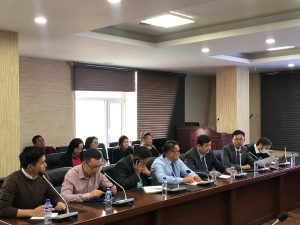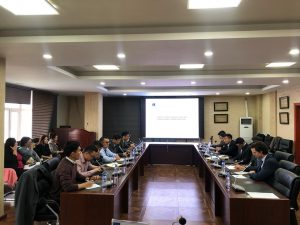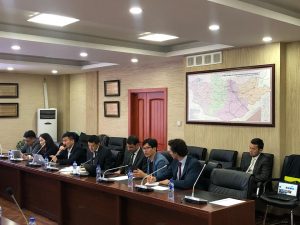 Ulaanbaatar, Mongolia, Oct 2, 2019 – GGGI Mongolia organized a Consultative Meeting on “Improving regulatory environment of Energy Storage Projects” in association with the Energy Regulatory Commission (ERC) and the National Dispatching Center (NDC) of Mongolia.
Ulaanbaatar, Mongolia, Oct 2, 2019 – GGGI Mongolia organized a Consultative Meeting on “Improving regulatory environment of Energy Storage Projects” in association with the Energy Regulatory Commission (ERC) and the National Dispatching Center (NDC) of Mongolia.
The workshop was organized as part of the Renewable Energy Absorption Project implemented by the Global Green Growth Institute together with the Energy Regulatory Commission. The REAP project aims at facilitating the emergence of technological and other options to improve the flexibility of the Mongolian central energy system, in order to increase the absorption of renewable energy and improve energy security.
The aim of the meeting was to engage and train technical stakeholders in energy storage, including battery technologies, and provide an introduction to evolving regulations for ancillary services. The workshop will be followed by the development of regulations and economic impact assessment for pricing and assessment of the network to define optimal battery technology, least cost, and optimal locations on the network.
 This assessment will include load flow analysis accounting for high, medium and low renewable energy dispatch scenarios. The regulatory work will help define the battery purchase agreement and network assessment will result in the identification of subprojects to be agreed with the National Dispatching Center. The audiences of the workshop were representatives of decision makers and regulatory bodies as well as technical engineers and staff of MoE, ERC, NDC, NREC, and EDC.
This assessment will include load flow analysis accounting for high, medium and low renewable energy dispatch scenarios. The regulatory work will help define the battery purchase agreement and network assessment will result in the identification of subprojects to be agreed with the National Dispatching Center. The audiences of the workshop were representatives of decision makers and regulatory bodies as well as technical engineers and staff of MoE, ERC, NDC, NREC, and EDC.
Mr. Tuvshichuluun, State Commissioner of ERC, delivered an opening speech. “We have a good cooperation with GGGI in many areas. REAP is one of the areas that we are working successfully. Battery storage is the one of the most important solutions to ensure stability of energy system. In terms of setting tariff for the battery storage, we don`t have sufficient experience and knowledge. I do believe that today`s event will have a great contribution in improved knowledge of setting the tariff and in future development of energy storage projects,” highlighted Mr. Tuvchinchuluun.
 Romain Brillie, GGGI Country Representative said “Under its commitments to the Paris Agreement on climate change Mongolia has set a target to increase renewable electricity capacity from 7.62% in 2014 to 20% by 2020 and to 30% by 2030 as a share of total electricity generation. This will require additional flexibility of energy systems to effectively translate installed capacity into generated and supplied electricity. Energy storage systems are one option that can help improve load management and the effective absorption of renewable energy on the grid, while improving its stability and, for Mongolia, energy security. I always appreciate that ERC is supporting GGGI’s work in energy sector for many years. I am happy that we have turned another new chapter in cooperation in energy battery storage. From GGGI side we will provide technical support on formalization of battery purchase agreement,” in his opening speech.
Romain Brillie, GGGI Country Representative said “Under its commitments to the Paris Agreement on climate change Mongolia has set a target to increase renewable electricity capacity from 7.62% in 2014 to 20% by 2020 and to 30% by 2030 as a share of total electricity generation. This will require additional flexibility of energy systems to effectively translate installed capacity into generated and supplied electricity. Energy storage systems are one option that can help improve load management and the effective absorption of renewable energy on the grid, while improving its stability and, for Mongolia, energy security. I always appreciate that ERC is supporting GGGI’s work in energy sector for many years. I am happy that we have turned another new chapter in cooperation in energy battery storage. From GGGI side we will provide technical support on formalization of battery purchase agreement,” in his opening speech.
GGGI technical experts Muharrem Askin and Andrew Lee have delivered presentations on GGGI Global Practices, main principles of the successful Power Purchase Agreements and Principles applied to PPAs in ESS and its ancillary services in Mongolia.
The Government of Mongolia (GOM) is in the process on considering battery storage to address the stability of the network, improve quality of service, and better manage loads to meet demand. However, there is a need for an assessment of the most suitable type of technology and institutional options to help improve grid flexibility and absorption of renewables. For batteries, this includes the type of technology, their physical location and related benefits, including financial. Battery storage can provide a wide range of ancillary services that helps the utility stabilize the network and improve quality of electricity supply. In addition, a key advantage of battery technology lies in its quick ability to respond to blackouts and provide ramping capacity.
The proposed REAP is planned to be a comprehensive engagement that will help the GOM, the offtaker, and the ERC to transparently take cost effective investment decisions to address the fragile network, improve service delivery, and pave the way for improved absorption of renewable energy and energy security.
Background
In Mongolia’s nationally determined contribution (NDC) a series of policies and actions are outlined to achieve a 14% reduction in greenhouse gas (GHG) emissions. This reduction on GHG can only be achieved if emissions from the energy sector are addressed. As such, Mongolia has established ambitious targets to increase renewable energy and reduce losses in the sector which include to increase renewable electricity capacity from 7.62% in 2014 to 20% by 2020 and to 30% by 2030 as a share of total electricity generation capacity and to reduce electricity transmission losses from 13.7% in 2014 to 10.8% by 2020 and to 7.8% by 2030.
Mongolia’s power sector is dominated by inefficient, soviet-era coal power plants which make up 85% of total installed capacity (920 of 1082MW). In 2016, 96% (5.5GWh) of domestic power was generated by coal plants which makes Mongolia’s power supply one of the most carbon intensive in the world. Since 2013 Mongolia has made steps to increase the share of renewable energy but it is far from reaching its resource endowment potential. As of May 2018 there are 2*10MW solar plants and 2*50MW wind farms operational. Another 30MW of solar PV has achieved financial close.
While the government has issued a number of licenses to independent power producers for renewable energy, the ability of these projects (or other) to be realized and lead to displacement of fossil fuels will largely depend on the ability of the network to absorb and manage intermittent and variable loads. Thus, one of the key constraints to scaling renewable energy is the fragile network and the absence of ramping capacity. High system losses, frequency fluctuations and voltage drops result in inadequate and poor quality of electricity services.